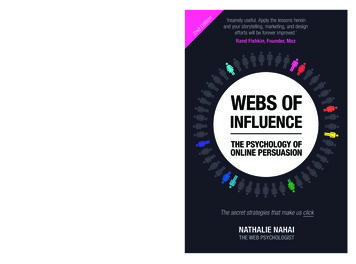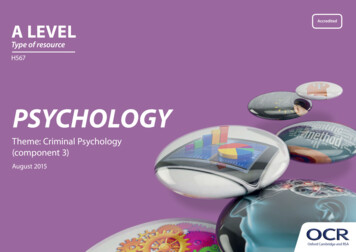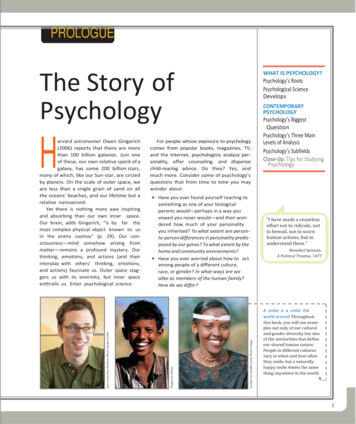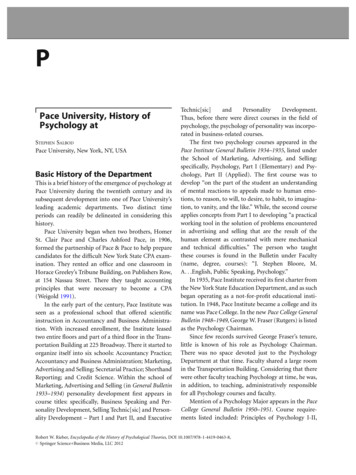
Transcription
INFLUENCETHE PSYCHOLOGY OFONLINE PERSUASION‘Nathalie Nahai is the mostintelligent contemporary writer ontechnology matters. This new edition iseven better and will turn every readerinto an expert: a phenomenal book!’With the majority of commercial transactions now happening online,companies of all shapes and sizes face an unprecedented level ofcompetition to win over and retain new business.This book will show you how to apply specific principles to improve yourmarketing, products and websites, enabling you to engage with yourcustomers in a more meaningful way.BUSINESS2ndEditionNATHALIENAHAICVR NAHA34604 02 SE CVR.indd 1 15.99WEBS OFINFLUENCETHE PSYCHOLOGY OFONLINE PERSUASIONTHE PSYCHOLOGY OFONLINE PERSUASIONIn this second edition of Webs of Influence, Nathalie Nahai bringstogether the latest insights from the worlds of psychology, neuroscienceand behavioural economics to explain the underlying dynamics andmotivations behind consumer behaviour.www.pearson-books.comEdit ionJamie BartlettAuthor, The Dark NetDr Tomas Chamorro-PremuzicProfessor of Business PsychologyUCL and Columbia UniversityVisit our website at‘Insanely useful. Apply the lessons hereinand your storytelling, marketing, and designefforts will be forever improved.’Rand Fishkin, Founder, MozWEBS OF INFLUENCE2nd Edition2ndWEBS OF‘Applying the latest thinking inpsychology, sociology, business,design and more, this book isessential reading for anyone whoworks on the web.’The secret strategies that make us clickNATHALIE NAHAITHE WEB PSYCHOLOGIST12/12/2016 11:10
Praise for Webs of Influence‘At Unilever, we have worked with Nathalie for the past several years. She has enableda step-change in our approach to communication through her amazing insight andexpertise, which has allowed us to deliver stronger relationships with our consumersas well as secure stronger sales.’Joe ComiskeyeCommerce Innovation, Unilever‘A fascinating dive into the psych-tech nexus, Webs of Influence combines in-depthresearch with practical guidance to expose the hidden techniques behind onlinedesign, marketing and sales. You may never look at the web in the same way again.’Geoff WhiteChannel 4 News‘Nathalie offers unique insight and understanding to those of us grappling with theimplication of an increasingly virtual existence - how we act in it and how we monetiseexperiences in it. This is critical reading for all of us making strides with our digitaltransformation.’Joshua MachtGroup Publisher and Executive Vice President,Harvard Business Review‘If you liked Nudge and work in digital marketing, this is the book you’ve been looking for.’Stanislas MagniantOnline Comms Director, Western Europe, Coca-Cola‘Webs of Influence is the industry’s definitive guide on the art and science of digitalpersuasion. Once again, Nathalie Nahai synthesises the latest neuroscience research,and teaches us how to inspire audiences to connect and engage online.’Sarah DeRocher MooreVP of Brand and Revenue Marketing, Spredfast‘A terrific and mind-expanding foray in the drivers of online persuasion.’Shane Parrishfounder, Farnamstreetblog.com‘My most recommended book on persuasive design by one of my very favouriteexperts. Nathalie Nahai’s book is a gift to our industry. It’s comprehensive, accessibleand jam-packed with insights.’Nir Eyalauthor, Hooked: How to Build Habit-Forming Products‘Nathalie has a knack for making you look at the website you work on every day witha completely fresh pair of eyes. Her knowledge and enthusiasm seep through theA01 NAHA4604 02 SE FM.indd 113/12/2016 14:33
pages of this book, and have got the whole team “thinking like a customer”. We’ve hadsome great successes with ideas she suggested, but more importantly, she’s helpedus to start thinking in the right way about the experience we offer our customers.’Susannah Ellisenergy website product owner, uSwitch‘A great summary of what we know about the psychology of web site design. Nathalie’slatest book hits the mark. It’s a must-read if you are planning or designing a website.’Susan Weinschenk, Ph.DChief Behavioural Scientist, The Team W, Inc., author,100 Things Every Designer Needs To Know About People‘Nathalie’s insights into the online influence of behaviour and how that should informa brand’s authenticity, originality, and overall marketing approach are incredible;immensely practical for all companies, from small business to enterprise.’Toby Danielsco-founder and CEO, Crowdcentric‘Nobody has done more to turn psychology research into practical advice for webdesigners than Nathalie Nahai. Every marketer needs Webs of Influence!’Roger Dooleyauthor, Brainfluence‘A very useful guide to applying behavioural research to the way you present yourbusiness online, full of fascinating real examples and practical tips.’Caroline WebbCEO, Sevenshift, author, How to Have a Good Day,Senior Adviser, McKinsey & Company‘It is so rare to find a book like Nathalie’s: well-written, thoroughly-researched, neverdry, and, most importantly, insanely useful. Apply the lessons herein and your storytelling, marketing and design efforts will be forever improved.’Rand Fishkinfounder, Moz‘Nathalie brings the psychology of online behaviour to life with tremendous insight,intellectual rigour and that rare commodity – practical advice. A thought-provokingwriter whose charm, energy and enthusiasm for her subject inspires audiences andencourages debate.’Lindsay SpencerHead of Communications, The DTG (Digital TV Group)‘A fabulous book that is a must-read for anyone serious about applying genuine behavioural insights to improve their digital presence.’Dr Joe DevlinHead of Experimental Psychology, UCL‘Simply the best, most straightforward insights into how our psychology drives ourbehaviour online - and how to harness it. No one does it better!’Martin Erikssonco-founder and curator, Mind the ProductA01 NAHA4604 02 SE FM.indd 213/12/2016 14:33
‘A brilliantly accessible guide to help you navigate the complicated world of how andwhy people make the decisions they do online. Applying the latest in thinking inpsychology, sociology, business, design and more, this book is essential reading foranyone who works on the web.’Jamie Bartlettauthor, The Dark Net‘Nathalie Nahai is the most intelligent contemporary writer on technology matters. Thefirst edition of Webs of Influence was a game-changer for anyone interested in understanding the interface between psychology, consumer behaviour, and the digital world.This new edition is even better and will turn every reader into an expert: A phenomenalbook!’Dr Tomas Chamorro-PremuzicProfessor of Business Psychology, UCL andColumbia University, CEO, Hogan Assessments‘Nathalie has repeatedly challenged my assumptions about how and why peoplebehave the way they do online. Her arguments are grounded in science and a deepunderstanding of people. As someone with no background in psychology, I’ve learneda huge amount from her writing and speaking. You should buy this book if you want tounderstand the reasons why people’s online behaviour is the way it is.’Will Critchlowfounder and CEO, Distilled‘A contemporary look at the technologies and techniques influencing us on a dailybasis, and breaks down the principles at play with remarkable clarity and insight. Websof Influence is an essential read for anyone looking for a deeper understanding of whywe behave online the way that we do, and how to apply these psychological insightsin practice.’Phil NottinghamVideo Strategist, Wistia‘Required reading for online marketers. As marketing becomes more personalised, it’sessential to understand what motivates your audience and drives their behaviour. Websof Influence makes it easy to leverage psychological studies and process to improveyour online marketing – from copy to design, functionality and pricing.’Stephen Pavlovichfounder, Conversion‘Nathalie is hands-down one of the most articulate and observant members of thedigital marketing world. She has such a thorough understanding of how people whouse the web, think. Every time I read something she’s produced, I learn somethingnew.’Kelvin Newmanfounder and Managing Director, Rough Agenda‘Nathalie has a unique ability to make psychological research approachable to themasses. She is one of the most engaging speakers and writers out there.’Chris SavageCEO and co-founder, WistiaA01 NAHA4604 02 SE FM.indd 313/12/2016 14:33
‘Nathalie’s book is the most detailed and definitive guide to embracing the latest scientific research into clear steps to satisfy your customer’s deepest needs before theyrealise they have them. Webs of Influence will help you optimise every single elementof your digital communications.’Rich Millingtonfounder, Feverbee‘No doubt, Nathalie Nahai is the web psychologist and by picking up this book, you areholding the best possible knowledge in your hands. No matter if your job is to makewebsite users happier, to sell more, or even both, this content will catapult you to newdimensions of better UX.’André Morysauthor, Co-Founder, the Global Optimization Group‘I’ve seen over 100,000 landing pages, but remember very few. If you use Nathalie’sapproach to persuasion on your website, you’ll create marketing experiences yourcustomers will respond to, convert from, and most likely copy.’Oli Gardnerco-founder, Unbounce‘What Nathalie has to say should change the way you think about marketing, advertising and communications online.’Mitch JoelPresident, Mirum, author, Six Pixels of Separation andCTRL ALT Delete‘The science behind how we think, feel and act in a single book. Get it if you want tobe able to connect to your customers, and influence their actions.’Peep Lajafounder, ConversionXL‘The ecommerce world has never been so competitive, and if you’re a retailer or manufacturer who fails to listen to and understand the demands of your customers, thenyou’re soon going to be wondering why your products are gathering dust. Nathalieexplains that online persuasion is centred around three key principles: know who you’retargeting, communicate persuasively, and sell with integrity.’Dave HowardGlobal Marketing Director, Brandview‘If you are hoping to make any sort of impact online, but aren’t practicing what Nathalieis preaching, you’ll find yourself coming up short. Practical advice, well-delivered androoted in research. A book that’s rarely farw from my desk.’David GreenwoodSenior Account Director, This is Pegasus‘Design user experiences that produce results with this excellent and practical book. Oneof the leading voices in applied behavioral sciences, Nathalie Nahai brings scientificinsights and rigour to your work. A must-read for designers and marketers!’Alex Osterwalderentrepreneur and author, co-founder, StrategyzerA01 NAHA4604 02 SE FM.indd 413/12/2016 14:33
Webs of InfluenceA01 NAHA4604 02 SE FM.indd 513/12/2016 14:33
At Pearson, we have a simple mission: to help peoplemake more of their lives through learning.We combine innovative learning technology with trustedcontent and educational expertise to provide engagingand effective learning experiences that serve peoplewherever and whenever they are learning.From classroom to boardroom, our curriculum materials, digitallearning tools and testing programmes help to educate millionsof people worldwide – more than any other private enterprise.Every day our work helps learning flourish, andwherever learning flourishes, so do people.To learn more, please visit us at www.pearson.com/ukA01 NAHA4604 02 SE FM.indd 613/12/2016 14:33
WEBS OFINFLUENCETHE PSYCHOLOGY OFONLINE PERSUASIONThe secret strategies that make us clickNATHALIE NAHAITHE WEB PSYCHOLOGISTHarlow, England London New York Boston San Francisco Toronto Sydney Dubai Singapore Hong KongTokyo Seoul Taipei New Delhi Cape Town São Paulo Mexico City Madrid Amsterdam Munich Paris MilanA01 NAHA4604 02 SE FM.indd 713/12/2016 14:33
Pearson Education LimitedEdinburgh GateHarlow CM20 2JEUnited KingdomTel: 44 (0)1279 623623Web: www.pearson.com/ukFirst published 2012 (print and electronic)Second edition published in Great Britain 2017 (print and electronic) Nathalie Nahai 2012 (print and electronic) The Web Psychologist 2017 (print and electronic)The right of Nathalie Nahai to be identified as author of this work has been asserted by her in accordance with the Copyright, Designs and Patents Act 1988.Pearson Education is not responsible for the content of third-party internet sites.ISBN: 978-1-292-13460-4 (print)978-1-292-13461-1 (PDF)978-1-292-13462-8 (ePub)British Library Cataloguing-in-Publication DataA catalogue record for the print edition is available from the British LibraryLibrary of Congress Cataloging-in-Publication DataA catalog record for the print edition is available from the Library of CongressThe print publication is protected by copyright. Prior to any prohibited reproduction, storage in aretrieval system, distribution or transmission in any form or by any means, electronic, mechanical,recording or otherwise, permission should be obtained from the publisher or, where applicable, alicence permitting restricted copying in the United Kingdom should be obtained from the CopyrightLicensing Agency Ltd, Barnard’s Inn, 86 Fetter Lane, London EC4A 1EN.The ePublication is protected by copyright and must not be copied, reproduced, transferred, distributed, leased, licensed or publicly performed or used in any way except as specifically permittedin writing by the publishers, as allowed under the terms and conditions under which it was purchased,or as strictly permitted by applicable copyright law. Any unauthorised distribution or use of this textmay be a direct infringement of the author’s and the publisher’s rights and those responsible may beliable in law accordingly.All trademarks used herein are the property of their respective owners. The use of any trademark inthis text does not vest in the author or publisher any trademark ownership rights in such trademarks,nor does the use of such trademarks imply any affiliation with or endorsement of this book by suchowners.10 9 8 7 6 5 4 3 2 121 20 19 18 17Print edition typeset in 9.5/14pt Helvetica by SPi GlobalPrint edition printed and bound in MalaysiaNOTE THAT ANY PAGE CROSS REFERENCES REFER TO THE PRINT EDITIONA01 NAHA4604 02 SE FM.indd 813/12/2016 14:33
To you, dear reader.May this book serve as a companionto help you build a better business, anda more human-centred web.A01 NAHA4604 02 SE FM.indd 913/12/2016 14:33
CONTENTSA01 NAHA4604 02 SE FM.indd 1013/12/2016 14:33
.Publisher’s acknowledgements ¿½å � xiiAbout the author ¿½å ����å ��������� xiiiPart 1 KNOW WHO YOU’RE TARGETING12345Introduction.4The psychology of decision-making.6Who are you targeting?.9Cultural quirks.11Individual differences.39Part 2 COMMUNICATE PERSUASIVELY67891011Basic principles. 60Optimising your website. 67Selecting the right images.88The psychology of colour ¿½å ����å ���97Social media and customer service.110Designing persuasive videos.120Part 3 SELL WITH INTEGRITY1213141516Influence: An introduction.130Principles of online persuasion.136Increase your sales.162Pricing and value.174The behaviour chain.185A closing note.192Notes.193Index.229xiA01 NAHA4604 02 SE FM.indd 1113/12/2016 14:33
Publisher’s AcknowledgementsWe are grateful to the following for permission to reproduce copyright material:Photo on page xiii by Jo Koralewska; tables 4.1, 4.2, 4.3, 4.4, 4.5, 4.6 adaptedfrom Hofstede, G., Hofstede, G. J. and Minkov, M., Cultures and Organizations:Software of the Mind, McGraw-Hill 2010, Geert Hofstede B. V.; screenshots onp 75 courtesy of bellroy.com; screenshot on p 79 courtesy of ugmonk.com; screenshot on p 90 courtesy of MOO; table 15.1 adapted from Effects of 9 Price Endingson Retail Sales: Evidence from Field Experiments, Quantitative Marketing andEconomics, 1(1), pp. 93–100, p.94 (Anderson, E. T. and Simester, D. I. 2003);reproduced courtesy of Springer Verlag.xiiA01 NAHA4604 02 SE FM.indd 1213/12/2016 14:33
About the Aâ ›uthorNathalie Nahai is a web psychologist, international speaker andHaving worked with Fortune 500Â consultant.companies including Unilever, Google andHarvard Business Review, she helps businesses apply scientific rigour to their websitedesign, content marketing and products.Nathalie presents at conferencesaround the world on the science of onlinepersuasion, and contributes to nationalpublications, TV and radio on the subject.She also sits on the Social Media Weekadvisory board and Ogilvy Changeexperts’ panel.You can tweet to her @NathalieNahaiand find out more at nathalienahai.comSource: Photo by Jo KoralewskaxiiiA01 NAHA4604 02 SE FM.indd 1313/12/2016 14:33
A01 NAHA4604 02 SE FM.indd 1413/12/2016 14:33
PART1Know Who You’reTargetingM01 NAHA4604 02 SE C01.indd 113/12/2016 14:35
DECISION-MAKING‘‘Cognition by itself cannotproduce action; to influence behavior,the cognitive system must operatevia the affective systemBIAS AND OVERRIDEour conscious decision-making processesPLASTICITYOpennessIntellectually usIndependentOpen-mindedEmotionally self-awareM01 NAHA4604 02 SE C01.indd 2ExtraversionEnjoys aboriousIntentionalRationalSYSTEM1 2SYSTEMPERSONALITY TRAITSTColin Camerer, et al.Ancient, automatic responses in the brain odicalGood impulse ly responsive13/12/2016 14:35ENSRCRUC
tr,emCULTURAL QUIRKSHOFSTEDE’S 6 DIMENSIONSTraitScoreCountryl.nEslssal0 10 20 30 40 50 60 70 80 90 100 110 TY AVOIDANCELONG-TERM ORIENTEDINDULGENCEGLOBAL INTERNET PENETRATION RATESS. AFRICA*BRAZILCHINAINDIAJAPANRUSSIASAUDI ARABIA*UKUSA*NO DATA AVAILABLE FOR LONG-TERM ORIENTED TRAITGENDER DIFFERENCESBEHAVIOURSEmotional StabilityWomen are more likely to:Provide inaccuratepersonal informationRead a site’s privacy policiesand change their personalsettings accordinglyEven-temperedNot easily lCopes with setbacksM01 NAHA4604 02 SE C01.indd 3Blog anonymouslyPost modest photosSeek out health informationParticipate more activelyon social media platformsMen are more likely to:Go online for gaming,betting, and entertainmentSpend more time and moneyshopping online (UK, USA)Research productsShare their phone numberand address with companiesand on social platformsDownload and listen tomore music and videos13/12/2016 14:35
1“IntroductionFor many, Internet access is no longer a luxury, but a necessity; it hasbecome an obligatory component for economic, political, cultural, andindividual representation and empowerment.E. B. WEISER, PSYCHOLOGISTâ ›1Since so many of our daily activities take place online, it is now harder than everfor businesses to grab, hold and convert their customers’ increasingly fragmentedattention. Those that do succeed are the brands that understand their customers’needs and can deliver the solutions to their problems in a frictionless way.  Whateveryour business, whomever you’re targeting, to succeed online there are three fundamental principles you must be able to fulfil:1 Know who you’re TargetingUnderstand the universal, cultural and individual factors that influence your audience’s decision-making processes.2 Communicate PersuasivelyKnow how to use language, non-verbal cues and visual design to communicateeffectively with your target audience.3 Sell with IntegrityUse psychological persuasion principles to facilitate (rather than coerce) yourcustomers towards a mutually beneficial outcome.4M01 NAHA4604 02 SE C01.indd 413/12/2016 14:35
With this in mind, the book is divided into three parts. Within each you’ll findcutting-edge insights and research from which the principles are drawn, real-worldexamples of how they can be applied, and how-to sections to help you implementthem in your business.IntroductionM01 NAHA4604 02 SE C01.indd 5513/12/2016 14:35
2“The Psychology ofDecision-MakingCognition by itself cannot produce action; to influence behavior, thecognitive system must operate via the affective system.COLIN CAMERER ET AL., BEHAVIOURAL ECONOMISTSâ ›1Although it’s comforting to believe that we make decisions from a rational place,in recent years mounting evidence to the contrary has disabused many of us ofthis notion. A considerable number of studies and theories suggest that ourdecision -making can in fact be significantly influenced and biased by our emotional processes.One of the most widely cited of these is the semantic marker hypothesis, amechanism proposed by neuroscientist Antonio Damasio which provides evidencethat certain sub-cortical regions in the brain contribute emotional weight to thedecisions we make.2,3 Given that people with lesions (damage) to these brainstructures can be impaired when making certain types of decisions,4 many havetaken these findings to mean that emotion is at the route of all decision-making –the reality is, however, much more complex.One Brain, Two SystemsIn his book entitled Thinking Fast and Slow,5 Daniel Kahneman (a Nobel Prize-winning psychologist) proposed that our brains rely on a  dual-core systemto process information and make choices. He describes the first system as automatic (emotional) and the second as controlled (cognitive). 6 These two processescan be roughly distinguished by where they occur in the brain,7 and together theyform the backbone of our decision-making. If we understand how each systemworks, we can use this knowledge to make better decisions and influence thoseof the people around us.6M02 NAHA4604 02 SE C02.indd 613/12/2016 14:35
According to Kahneman, System 1 (thinking fast) is intuitive, automatic andgenerally operates below the level of our conscious awareness.8 It is in this subconscious setting that we undergo different affective (emotional) states, many ofwhich motivate impulse reactions and feelings such as hunger, fear, sexual desireand pain. These states can even have a bearing on the way we perceive andremember things and can affect everything from our ability to learn to the goalswe choose to pursue.9Psychologist Zajonc10 explains that these are the same processes that motivateus to approach or avoid something – decisions on which we depend to survive.It’s this system that ‘knows’ when our partner is in a bad mood, or instinctivelyswerves the car when a child walks out on to the road. It’s our hunch, our intuition,and it informs almost everything we do.System 2 (thinking slow) is altogether more analytical, deliberate and rational;it is the mode that we employ to reason about the world. It’s the system we useto consciously work out a maths sum or fill out a tax return and it’s usually ratherlabour intensive. We like to think that System 2 runs the show, but it is, by its verynature, a ‘lazy’ system that has to cherry pick what it will and won’t attend to – wecan’t consciously analyse everything all the time. In fact, it’s this slow, controlledsystem that tends to kick in when our automatic processes get interrupted. Thiscan happen when experiencing a strong visceral state (someone steals yourwallet and you’re furious), when we encounter an unexpected event (yourmother-in-law drops by unannounced and you have to put on a smile) or whenwe come up against an explicit challenge (solving a cryptic crossword in theSunday paper).When it comes to decision-making, System 1 will continually generate feelings,intuitions and intentions, which, if endorsed by System 2, will turn into beliefs andactions. This interplay works well until we’re asked to respond to something thatviolates our normal understanding of the world (a flying pig) or requires greatercognitive attention (the end-of-year report). At this point, it’s System 2 that stepsin, helping us to weigh up the facts (pigs can’t fly, it must be an illusion) andrespond appropriately (laugh it off).Although we’d like to think we’re rational, in reality, it’s our fast, automatic system that’s in charge. System 1 relies on heuristics (cognitive rules of thumb) toreduce the complexity of incoming information and speed up our decision-makingwhich, most of the time, works just fine. For instance, employing the principle ‘Youget what you pay for’ tends to be useful when having to make decisions in general,but in the absence of System 2’s more rational approach, our automatic processescan sometimes fall prey to biases.The Psychology of Decision-MakingM02 NAHA4604 02 SE C02.indd 7713/12/2016 14:35
Take the Rational Choice Theory of economics.11 This states that people arerational agents that make logical decisions, by meticulously weighing up all theinformation, risks and probabilities inherent in a given situation. In real life, thiswould mean that strategies like decoy pricing should have zero effect on the financial decisions we make, since numbers are absolute. Yet research shows that thecontext or framing of a situation not only influences our perception of the facts, italso significantly impacts the decisions we go on to make.For instance, imagine that your friend asks you to go out and buy her someminced beef to make spaghetti bolognese. You go to the butcher’s and you seetwo options: ‘75 per cent lean’ versus ‘25 per cent fat’. The astute among you willhave noticed that mathematically both choices are identical. However, researchshows that we’re significantly more likely to buy the ‘75 per cent lean’ option,simply because of our positive association with ‘leanness’. 12 So what’s happening?Well, information is never free from the context in which it is delivered orreceived, and along with our associations, there are many ways in which thiscontext can skew our decisions. For example, we tend to pay more attention toinformation which comes easily to mind (the availability heuristic), and we oftengive greater weight to memories that are personally relevant, or emotionally vivid– which is why stories can be so powerful. We also tend to seek out informationthat enhances our self-esteem (self-serving bias) and reinforces our existingworld view (confirmation bias), all of which can heavily influence both the marketing messages we respond to, and the subsequent purchase decisionswe make.Whether we like it or not, the reality is that our decisions are influenced by awhole host of factors, many of which lay beyond our conscious awareness andcontrol. This means of course, that if we can understand how and why these principles work, we can also use them online to help shape the behaviours ofothers.8KNOW WHO YOU’RE TARGETINGM02 NAHA4604 02 SE C02.indd 813/12/2016 14:35
3“Who a↜re you Ta↜rgeting?Your personal core values define who you are, and a company’s corevalues ultimately define the company’s character and brand.TONY HSIEH, FOUNDER OF ZAPPOSâ ›1Before you can successfully ascertain your target audience, you first need to havea clear understanding as to the values, purpose and identity of your business. Ifyou have never developed a marketing strategy or if it has been a while since youupdated an existing one, you may find it useful to complete the exercises below.Take a few moments to carefully consider each of the following questions. Theanswers you provide (in particular to those regarding your target market) willdirectly determine how you’ll implement the principles in this book to influence andsuccessfully engage with your online a
INFLUENCE THE PSYCHOLOGY OF ONLINE PERSUASION ONLINE PERSUASION 'Insanely useful. Apply the lessons herein and your storytelling, marketing, and design efforts will be forever improved.' Rand Fishkin, Founder, Moz 2nd Edition 'Nathalie Nahai is the most intelligent contemporary writer on technology matters. This new edition is










